This past offseason, Pitcher List introduced Pitch Level Value, or PLV, a new set of comprehensive metrics that assess player performance by grading outcomes on the single pitch level. If you’re new to it all, be sure to read Nick Pollack’s primer on PLV here.
You’ll find the definitions below. Grades are on a 20-80 scale.
Swing Aggression: How much more often a hitter swings at pitches, given the swing likelihoods of the pitches they face.
Strikezone Judgement: The “correctness” of a hitter’s swings and takes, using the likelihood of a pitch being a called strike (for swings) or a ball/HBP (for takes).
Decision Value (DV): Modeled value (runs per 100 pitches) of a hitter’s decision to swing or take, minus the modeled value of the alternative.
Contact Ability: A hitter’s ability to make contact (foul strike or BIP), above the contact expectation for each pitch.
Power: Modeled number of extra bases (xISO on contact) above a pitch’s expectation, for each BBE.
Hitter Performance (HP): Runs added per 100 pitches seen by the hitter (including swing/take decisions), after accounting for pitch quality.
Pitch Level Average (PLA): Value of all pitches (ERA Scale), using IP and the total predicted run value of pitches thrown.
Pitch type PLA: Value of a given pitch type (ERA scale), using total predicted run values and an IP proxy for that pitch type (pitch usage % x Total IP).
This week we’re finally doing it. That’s right, we’re busting out the rolling charts. It’s time. Just as a caveat, I want to mention that for me I view them as a depiction of the results so far. Sometimes it can look like there’s a trend going on but that might not always be the case. Or sometimes it is the case, and there is, in fact, something afoot. Regardless, my hope is that the charts can at the very least give us a better way of visualizing results.
As far as the hitting metrics go, they’re all, of course, very useful. Batted ball data is in general a little noisy especially given thats we’re still relatively early in the season. Because of that, I like to lean on decision value the most. I think DV is a really intuitive way to assess a hitter’s ability by grading one of the few things they can control, which is swinging or not. As a reminder, DV stabilizes at around 500 pitches or about 32 games played.
Alright, enough of that. Buckle in because we’re about to get the full Scott Chu experience. Ok, maybe not quite, but I’m gonna try my best. And we’ll have some pitchers mixed in too.
(Note: All PLV data is current through Thursday 5/18).
The former Ray posted his third double-digit strikeout performance of the year last Saturday against the Cubs and now boasts a 2.16 ERA and 0.84 WHIP through 50 innings. Below are his PLV scores from the game which you can find on his player page under game logs. The fastball (59 pitches) was terrific and returned a 42.4% CSW and a pristine 1.56 pitch-type PLA. The strike zone plot highlights his heater command at the top of the zone. It’s very pretty, isn’t it?

So far the Ryan Express (I’m sorry Nolan who?) has returned a 1.97 pitch-type PLA which is third among all pitchers with at least 500 pitches. To the surprise of no one, Spencer Strider is first at 1.45 followed by Drew Rasmussen at 1.87. Gerrit Cole is behind Ryan at 2.13 followed by Zack Wheeler at 2.23.
Ryan’s fastball is really unique because it does well despite not having good velocity, at just under 93 on average. It’s similar to Paul Sewald whose fastball also grades out well with a PLA of 2.52. Ryan’s trick is having a flat fastball, also known as a good vertical approach angle.
Suwinski has hit the skids lately with a .559 OPS over his last 11 games. Strikeouts are going to be a thing (35-grade contact) but what I like about him is that he’s consistently demonstrated high-quality swings and takes as you can see with his decision value (70) below.
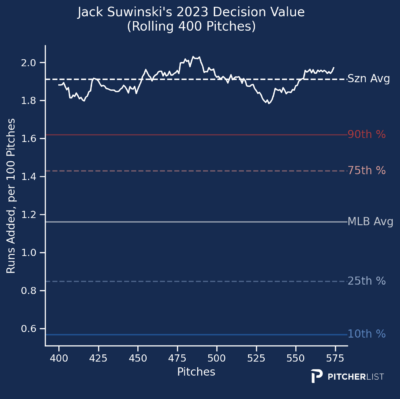
His 16.6% chase rate (99th percentile) is another way to look at it. He’s adding a ton of power (70) so I still believe in his outlook the rest of the way, although he’s probably best suited in daily leagues given his rough splits against LHP.
Burger has been flying off waiver wires lately. The sample size isn’t ideal (348 pitches) but he’s shown off light tower 80-grade power. Although curiously he only had a .130 ISO in 39 games with Triple-A Charlotte last year. Anyway, all that power might end up being bad for your cholesterol if you consider the rest of his profile: 25-grade strike zone judgment, 35-grade decision value, and 40-grade contact.
You might have noticed that LeMahieu has a 26.5% K rate which is by far a career-high. He still rates above average with contact (60) but as you can see below he’s fallen quite a bit in that area relative to where he was last season.
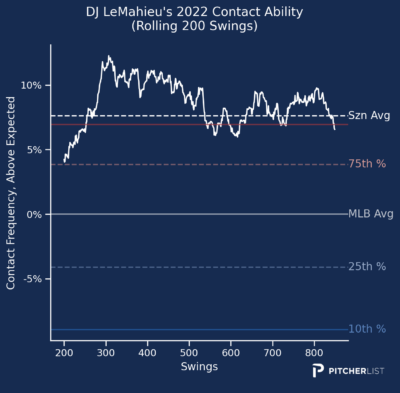
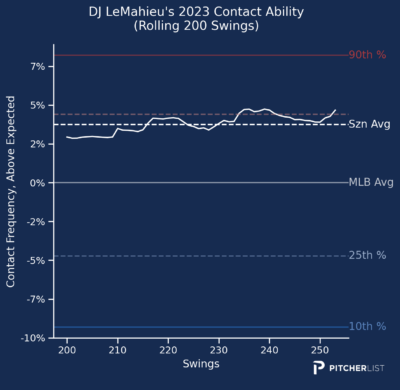
We talked about Soto a few weeks ago when he wasn’t doing a whole lot. He’s recovered nicely and his hitting for a .993 OPS over his last 12 games. He’s the only player that PLV has tracked this year with an 80-grade decision value. As you can see below, he’s really in a league of his own as far as making high-quality swings and takes.

The interesting thing is that he’s running a below-average contact grade of 45. I don’t think that’s not necessarily a bad thing because he consistently swings at great pitches to hit but it’s below his previous grades in 2022 (50) and 2021 (55).
Feel free to ignore Clarke Schmidt given his, you know, less-than-ideal 6.30 ERA and 1.65 WHIP. The big problem is against lefties as they’ve bludgeoned him for a .464 wOBA. But PLV seems to like at least some of what he’s doing.
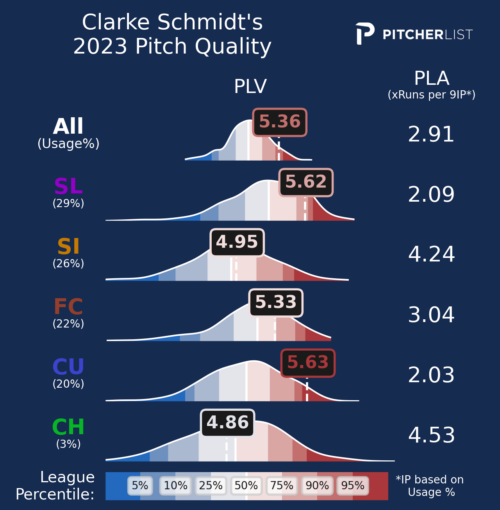
The slider’s PLA of 2.09 ranks 25th among pitchers with at least 500 pitches. And his curveball PLA of 2.03 ranks fifth.
Gunnar Henderson and Anthony Volpe
In week two, we took a very early look at some rookie hitters. Gunnar Henderson has struggled overall but he’s at least maintaining a decent OBP with above-average decision value (55) and above-average power (55). The problem though is his contact (40).
Henderson has a -10.3% swing aggression, which is the same mark as Juan Soto, that is to say, he’s pretty passive and it makes me wonder if maybe it’s putting him in too many two-strike counts.
Similar to Henderson, Anthony Volpe’s weakness is contact (40) as he’s hovering around the bottom 10th percentile. Although, Volpe has shown even better SZ Judgement (60) and decision value (60). What’s more, his power (55) has been trending way up.
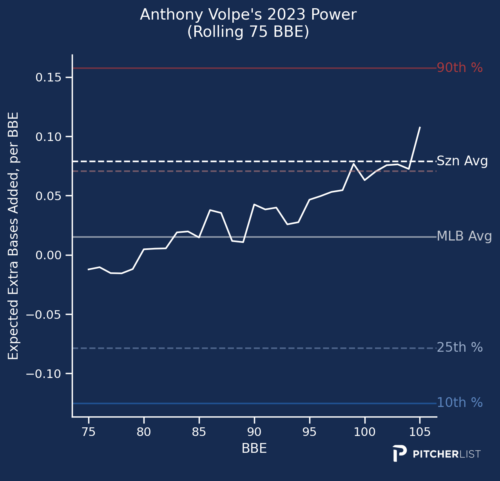
I’m stealing this from Kyle Bland as he posted this on Twitter @blandalytics earlier this week. Jorge Mateo was, for a moment at least, looking like a breakout but that ship might have sailed. He’s so far posted a 27.5% K rate in May.
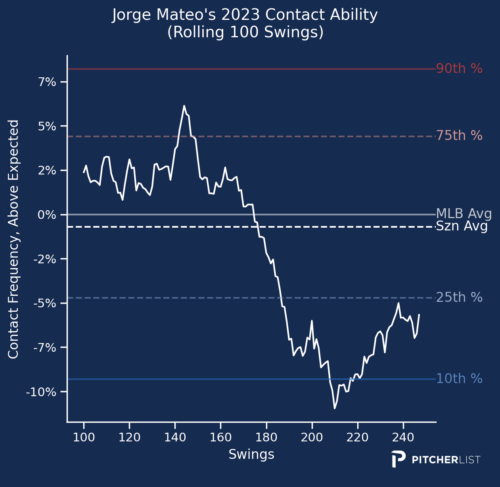
As I mentioned earlier, I like looking at decision value because it provides a better understanding of a hitter’s ability by putting a value on one of the few things that they can control: swinging or not. Kelenic’s results have been great (65 HP) but given his below-average contact (45) the recent dip in DV (45) might be a little concerning. Again sometimes the rolling charts can be misleading but yikes that’s some nosedive.
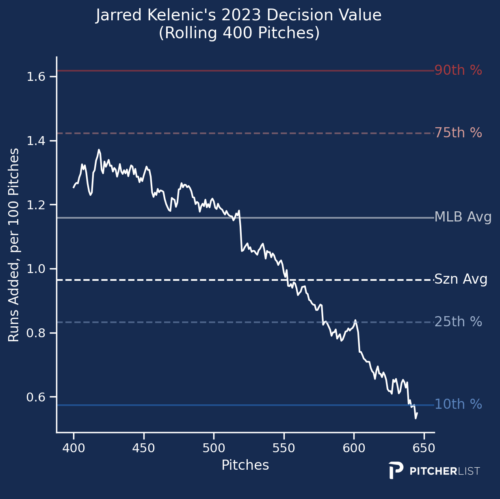
Another breakout, Brent Rooker has well below-average contact (35) so that’s a concern for sure. But his profile is buoyed by great swings and takes (65 DV).
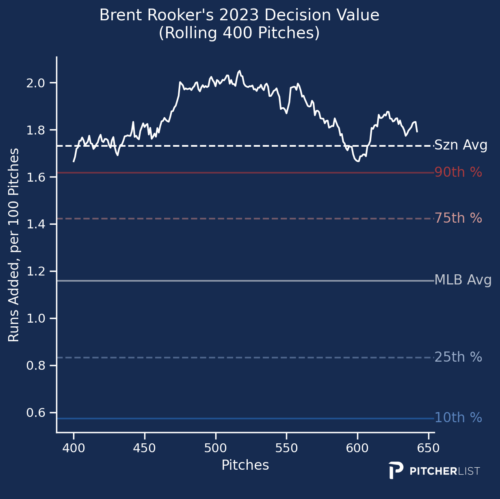
Nolan Arenado vs. Alex Bregman
I mentioned Arenado a couple of weeks ago when his bat was rather quiet, proceeded to cite his decision value as a possible reason to be concerned, and have since been exposed as a clown. Arenado, of course, has gone nuclear over the past 12 games with seven home runs and a 1.126 OPS. He’s also hitting .326 and stole his second base of the year too. If you have him on your fantasy team, you can thank me later.
Arenado is an interesting profile. If we’re judging him solely on the value of his swings and takes, he’s a below-average hitter. Granted, that might be a pointless distinction to make given the results are what most people care about and the results in the case of Arenado are a career .877 OPS.
As you’ll find below, he’s hovering around the 10th percentile in decision value (40 grade). Again, it’s kind of funny in light of his current heater because I think you’d probably guess, or at least I would, that he wasn’t doing much if were just looking at his DV. Alas, results matter. Who would’ve thought?
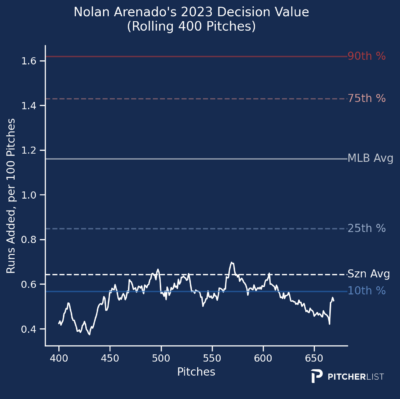
The way I think about Arenado is that because he’s adept at making contact (60) with average power (50) he’s simply able to accumulate enough good results. In that respect, he might be similar to his former teammate DJ LeMahieu (45 DV). Either way, maybe that rationale is pointless and the correct answer all along is that Arenado is, in fact, what you’d call a good hitter. Fine.
As far as decision value goes, Alex Bregman is an interesting foil to Arenado. He consistently grades out really well in DV. This year, Bregman has earned a 75 grade in DV. Soto is the only hitter at 80 and there are only two others with 75 grades in DV: Anthony Rendon and Trayce Thompson. Although, in the case of Thompson the sample size is a little light (333 pitches).
With Rendon currently on the shelf, I’ll be very curious to see how Bregman (.719 OPS) and Arenado (.762 OPS) compare moving forward. It could be an interesting sort of case study on using decision value as a way to evaluate hitters.
Bregman is also adding value in contact (60) which is really unique because, again, he’s generally only swinging at good pitches (i.e. ones that he’s expected to hit). His current 9.4% K rate is the lowest of his career. However, unlike Arenado, Bregman has a below-average power grade (45).
I’ll end this set of ramblings by noting that Arenado’s contact grade is down a little (60) relative to last year (65). His strikeout rate is also a career-high 19.5%. Huh…Sell high? (Ducks)
One of the latest exciting pitching prospects to get called up, Pérez picked up his first career W in his second start this Thursday against the Nationals. You’ll find the PLV game log for his second start below.

Through two starts, his fastball (78 pitches) has looked pretty good with a 5.57 PLV and 2.85 PLA. The fact that he debuted at 20 is of course a testament to his unreal talent. But one area to look for improvement is with his secondaries. So far, his slider (51 pitches) has returned an average-ish 4.57 PLV and 5.14 PLA. Again, the sample size is ridiculously small but I’ll be interested to see how the rest of his arsenal grades once he gets more experience.
Injuries to Kenta Maeda and Tyler Mahle have pushed Bailey Ober into the Twins’ starting rotation and he’s been impressive with an 18.1% K-BB% through five starts. This past Tuesday, he bottled up a formidable Dodger lineup and held them to just one run over six innings.
So far, his changeup has been his best offering with a 1.73 pitch-type PLA. Among pitchers with at least 450 pitches, Ober’s change ranks fourth behind Michael Wacha (0.96), Lucas Giolito (1.07), and Tyler Wells (1.45).
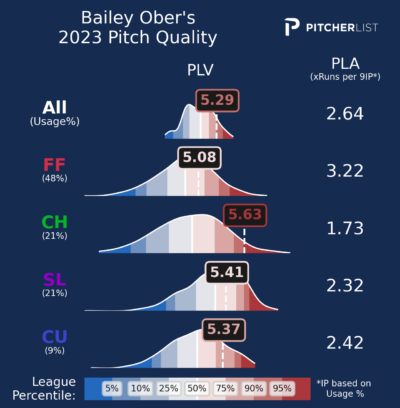
PLV Leaders
We’ll end with the list of the top ten pitchers by PLV with a minimum of 700 pitches.
If you’re a little worried about Julio Urías and his 4.39 ERA after a couple of clunkers including one against the Cardinals this past Thursday, this is a silver lining.
The same thing goes for Zack Wheeler. He’s had a couple of meh starts in his past three, but he’s about as rock-solid of a buy-low as you’ll find.
Otherwise, this looks like a pretty good list with no real surprises. Except, well, there’s Schmidt again. And, hey! Three cheers for JP Sears! He has a big test against the Astros today, and I’m rooting for him.
Photo by Nick Wosika/Icon Sportswire | Adapted by Justin Paradis (@JustParaDesigns on Twitter)

